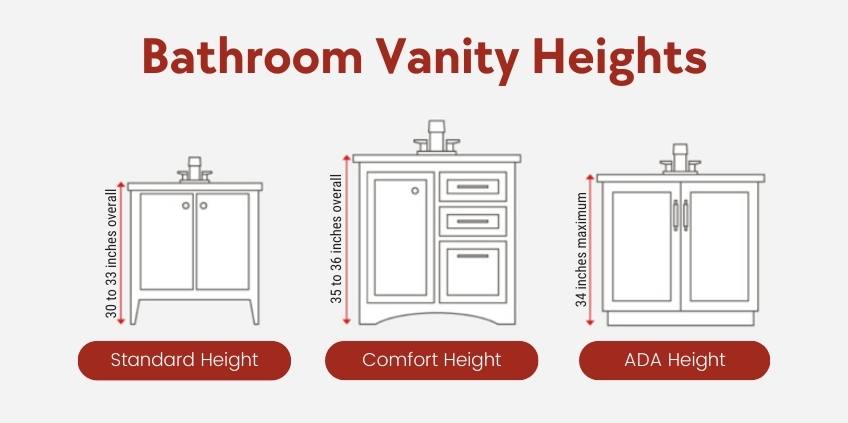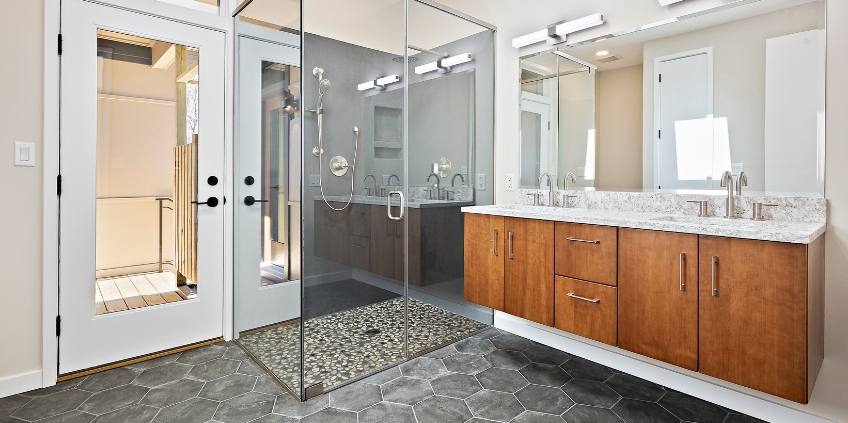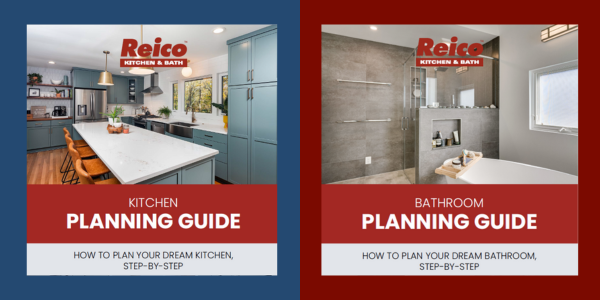The bathroom vanity is a central decision to most bathroom remodeling projects. Designed to serve multiple purposes, it typically includes a sink, countertop, and storage space. The vanity acts as a hub for your daily hygiene routines and essential items and is key element in a bathroom remodel's overall design.
When it comes to designing your dream bathroom, you might be wondering, what is the standard vanity height? Selecting the right bathroom vanity height is different for everyone, and influences functionality, aesthetics and experience.
Finding the perfect height ensures a comfortable, easy to use space for your daily routine. To help you make the right decision, we explore vanity height options and the factors to consider when choosing a vanity, along with some valuable insights from experienced designers at Reico Kitchen & Bath.
Bathroom Vanity Heights
A bathroom vanity height varies depending on the style and purpose it serves, with different options to accommodate various needs and preferences. One of the key considerations to determining the ideal vanity height is whether the measurement includes the thickness of the vanity top. It's crucial to be aware of all measurements to ensure the perfect fit and functionality.
Here are the most common vanity height options available:
- Standard Height (30 to 33 inches overall): The standard bathroom vanity height, ranging from 30 to 33 inches, is the most prevalent choice in many bathrooms. Typically designed based on 31 ½” high vanity cabinets, the total height can vary between 32 ¼” to 33”, depending on the thickness of the vanity top, which usually falls between ¾” to 1 ½”. This standard height is versatile and caters to a wide range of users, making it a popular option for most bathroom setups.
- Comfort Height (35 to 36 inches tall): Also referred to as counter height, the comfort height vanity is a taller vanity at 35 to 36 inches. This style mirrors the height of a standard kitchen countertop, offering a more ergonomic design and ease of use for adults. The 36” height is achieved through a combination of a 34 ½” high vanity cabinet and a vanity top thickness of up to 1 ½”. Comfort height bathroom vanities have gained popularity, especially in primary bathrooms. The elevated design not only adds a modern touch to the bathroom space but also provides practical benefits. One notable advantage is the accessibility to storage space, which is essential for keeping bathroom essentials neatly organized and within reach. In some circumstances, kitchen cabinets may be used to achieve similar height needs.
- ADA Height (34 inches maximum): For those prioritizing accessibility and universal design principles, the ADA height recommendation caps at 34 inches. Following NKBA guidelines, this height specification is ideal for accommodating individuals with disabilities or those who may require wheelchair access. Planning for ADA height ensures inclusivity and futureproofing your bathroom for potential mobility challenges.

Whether opting for the standard, comfort or ADA height, choosing the right vanity height is essential for creating a functional and visually appealing bathroom space tailored to individual preferences. By understanding the distinct characteristics and benefits of each vanity height option, homeowners can make informed decisions based on their specific needs and desired aesthetics that align with the space and overall bathroom size.
Katherine Dashiell, a Reico Kitchen & Bath designer in Annapolis, MD, emphasizes the importance of tailoring your bathroom vanity size to your specific needs: "A well-chosen vanity height enhances the functionality of your bathroom. I always discuss with clients who will use the bathroom the most and consider their needs, both now and in the future."
She further adds, "for some, comfort height is the perfect choice, while others prefer a standard bath vanity height for a more classic look. It's essential to align the vanity height with your lifestyle and long-term plans."
Considerations When Choosing Vanity Height
Whether you opt for a standard, comfort, or vessel sink height, the choice should reflect your personal style and the needs of your household. Consider all of these factors when making your decision:
- User Height and Needs: The primary factor to consider. A vanity's height should accommodate those who will use it most often. For a family bathroom, a standard height may be practical while a comfort height vanity can offer easier use for taller individuals. If your needs include a seating area for makeup, standard height works well and can easily accommodate a more traditional stool or seat. Regardless of your height, bending over to use a sink is harder on your back as you age so the taller height can even be good for shorter individuals.
- Sink Style: Whether as part of your vanity top or a piece to go on top of it, the type of bathroom sink you choose affects your ideal vanity height. A vessel sink sits fully above the countertop. They can add style and contemporary flair to your bathroom while still being very comfortable to use, particularly with standard height vanities. If using a taller vessel sink, take the overall height of the vessel into consideration when choosing vanity height. A tall vessel sink with a comfort height vanity may be uncomfortable to use or create a lot of splashing based on the user’s height.
- Aesthetic Preferences: The visual balance of your bathroom is crucial. Taller vanities can blend right in or create a more imposing look if your design includes a lot of cabinetries. Standard or lower vanities can make the space feel airier and open but may be less enjoyable to use if you and others are taller. Another option to finding the right height is considering a wall-hung or "floating" vanities. A floating vanity not only offer a unique look but also allow you to customize the height at which the vanity is mounted on the wall to suit the user's preferences.

- Aging in Place: If you plan to stay in your home long-term, choosing a comfort height vanity could help to accommodate potential mobility challenges in the future. This is an important conversation with your designer. “Comfort height might be helpful for back issues, but it will not accommodate all mobility changes. In some instances, you will need lower than comfort height that can be easily modified in the future for roll under. If seating is important, standard height can be a better option. This is important and something the clients really have to think honestly about,” explained Katherine.
The Perfect Height of your Bathroom Cabinet Awaits
While we focus on features such as storage, countertop space and other functional design aesthetics, the correct vanity height blends functionality and your own user experience into the design of the entire space. Don’t make it a one size fits all decision without carefully considering all the options available and all the users who will be impacted. Let Reico Kitchen & Bath's team of expert designers expertly guide you to finding the perfect vanity height for your dream bathroom.

